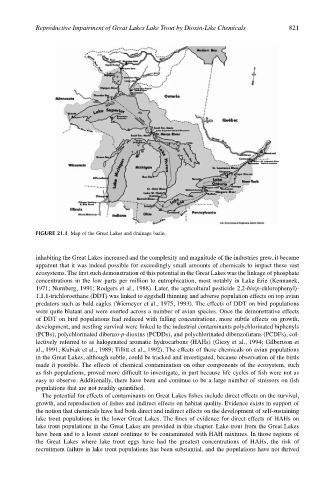Page 841 - The Toxicology of Fishes
P. 841
Reproductive Impairment of Great Lakes Lake Trout by Dioxin-Like Chemicals 821
FIGURE 21.1 Map of the Great Lakes and drainage basin.
inhabiting the Great Lakes increased and the complexity and magnitude of the industries grew, it became
apparent that it was indeed possible for exceedingly small amounts of chemicals to impact these vast
ecosystems. The first such demonstration of this potential in the Great Lakes was the linkage of phosphate
concentrations in the low parts per million to eutrophication, most notably in Lake Erie (Kennanek,
1971; Nurnberg, 1991; Rodgers et al., 1988). Later, the agricultural pesticide 2,2-bis(p-chlorophenyl)-
1,1,1-trichloroethane (DDT) was linked to eggshell thinning and adverse population effects on top avian
predators such as bald eagles (Wiemeyer et al., 1975, 1993). The effects of DDT on bird populations
were quite blatant and were exerted across a number of avian species. Once the demonstrative effects
of DDT on bird populations had reduced with falling concentrations, more subtle effects on growth,
development, and nestling survival were linked to the industrial contaminants polychlorinated biphenyls
(PCBs), polychlorinated dibenzo-p-dioxins (PCDDs), and polychlorinated dibenzofurans (PCDFs), col-
lectively referred to as halogenated aromatic hydrocarbons (HAHs) (Giesy et al., 1994; Gilbertson et
al., 1991; Kubiak et al., 1989; Tillitt et al., 1992). The effects of these chemicals on avian populations
in the Great Lakes, although subtle, could be tracked and investigated, because observation of the birds
made it possible. The effects of chemical contamination on other components of the ecosystem, such
as fish populations, proved more difficult to investigate, in part because life cycles of fish were not as
easy to observe. Additionally, there have been and continue to be a large number of stressors on fish
populations that are not readily quantified.
The potential for effects of contaminants on Great Lakes fishes include direct effects on the survival,
growth, and reproduction of fishes and indirect effects on habitat quality. Evidence exists in support of
the notion that chemicals have had both direct and indirect effects on the development of self-sustaining
lake trout populations in the lower Great Lakes. The lines of evidence for direct effects of HAHs on
lake trout populations in the Great Lakes are provided in this chapter. Lake trout from the Great Lakes
have been and to a lesser extent continue to be contaminated with HAH mixtures. In those regions of
the Great Lakes where lake trout eggs have had the greatest concentrations of HAHs, the risk of
recruitment failure in lake trout populations has been substantial, and the populations have not thrived

